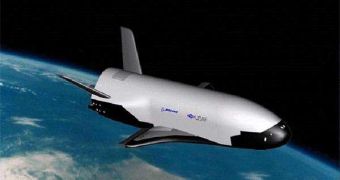After years of planning and research / development, Boeing and the United States Air Force (USAF) are finally ready to begin the testing sequence of their X-37B space plane, which is an unmanned military vehicle, designed to reach orbit, stay there, and then de-orbit safely and land. Flown entirely by remote control, the aircraft will have an airstrip at the Vandenberg Air Force Base at its disposal for landing, with a secondary one reserved at the Edwards Air Force Base. According to USAF officials, the first test flight is scheduled to take place in January 2010, when the aircraft launches aboard an Atlas V delivery system to low Earth orbit.
The vehicle has been dubbed X-37B OTV-1 (Orbital Test Vehicle 1), and is scheduled to be launched from Cape Canaveral, in Florida. Secretary of the Air Force Office of Public Affairs media relations officer Elizabeth Aptekar, who is also a USAF captain, recently announced that the craft was ready for testing, Space informs. “The vehicle is ready for the shipping process, which includes minor close-out activities. The vehicle will ship at the conclusion of the pre-ship activities, which should be approximately 60 days before its launch date,” she said.
Work on the concept began in July 199, when Boeing Phantom Works signed a four-year agreement with NASA for the development. Originally slated to be deployed from the cargo bay of a shuttle, the design was abandoned after the Columbia tragedy of 2003. After that, the project was significantly modified, and is now slated to be launched from an Atlas V rocket. The flight procedure states that, after the plane reaches orbit, it will carry out its mission there, and then reenter the Earth's atmosphere, for its California landing.
According to officials at NASA and Boeing, the role of the aircraft is to serve as a test base for newly developed systems, spanning areas such as propulsion, weapons, airframes, and operations. With each flight, X-37B will carry different experiments to a low-altitude orbit, which will perhaps make it more affordable for scientists to send their own samples into space as well. “Potential new commercial and military reusable space vehicle market applications for these technologies range from on-orbit satellite repair to the next-generation of totally reusable launch vehicles,” Boeing revealed in a press release issued some time ago.

 14 DAY TRIAL //
14 DAY TRIAL //